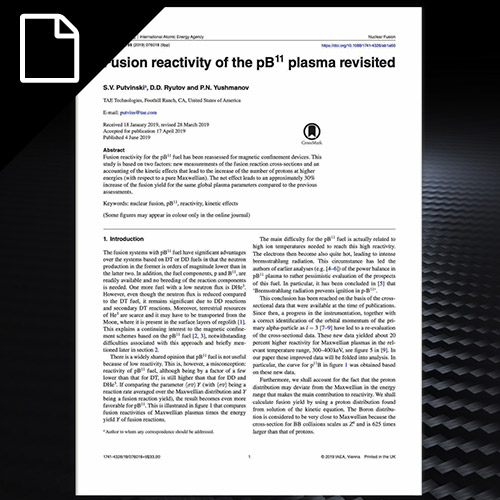Nov 2020 | Research Library, Papers, Fast Particles, Fusion Energy, Fusion Research, Fusion Science, Fusion Technology, Instabilities, Modeling, Plasma Research, Simulation, Waves
November 2020 | B.S. Nicks | Nuclear Fusion | Paper
In the scrape-off-layer (SOL) of a field-reversed configuration, neutral beam injection can drive
modes in the vicinity of the ion-cyclotron frequency

Nov 2020 | Research Library, Papers, Experiment, Fusion Energy, Fusion Research, Fusion Science, Fusion Technology, Plasma Research, Simulation
November 2020 | L. Steinhauer | Physics of Plasmas | Paper
A reconstructor tool is developed for fast computation of fully two-dimensional equilibria of FRCs that are consistent with routine magnetic data from experiments.

Oct 2020 | Research Library, Papers, Experiment, Fusion Energy, Fusion Research, Fusion Science, Fusion Technology, Instabilities, Plasma Research, Simulation
October 2020 | C. Scott | Nuclear Fusion | Paper
Energetic beams excite semi-repetitive modes (‘staircase mode’) in the field-reversed configuration (FRC) plasma.

Sep 2020 | Research Library, Papers, Experiment, Fusion Energy, Fusion Research, Fusion Science, Fusion Technology, Heating, Plasma Research, Waves
September 2020 | X. Yang | AIP Conference Proceedings | Paper
Simulation survey performed at TAE Technologies, has demonstrated that HHFW heating is a promising scenario to heat core electrons of FRC plasma.

Aug 2020 | Research Library, Papers, Fusion Energy, Fusion Research, Fusion Science, Fusion Technology, Plasma Research, Simulation
August 2020 | C. Lau | Physics of Plasmas | Paper
A quasi-neutral blended drift-Lorentz particle model of the field-reversed configuration (FRC) has been developed and implemented in the particle-in-cell code named ANC.
